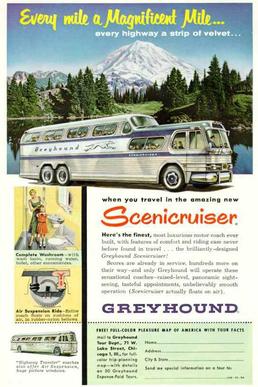Scenicruiser
| PD-4501 Scenicruiser | |
|---|---|

Greyhound ad showing a Scenicruiser
|
|
| Overview | |
| Manufacturer | GMC |
| Production | 1,001 units |
| Body and chassis | |
| Class | Commercial vehicle |
| Doors | 1 door |
| Floor type | Aisle with raised seat platforms on each side, step entrance |
| Powertrain | |
| Engine |
|
| Transmission |
|
| Dimensions | |
| Length | 40 feet (12.19 m) |
| Chronology | |
The GM PD-4501 Scenicruiser, manufactured exclusively by General Motors for The Greyhound Corporation, was a three-axle monocoque two-level coach used by Greyhound from July 1954 into the mid-70's. 1,001 were made between 1954 and 1956.
The Scenicruiser became an icon of the American way of life due to its presence throughout the USA in cities and along highways and popularity with the traveling public. The name was a portmanteau of the words "scenic" and "cruiser".
The high-level design concept of Scenicruiser resembles some of the rolling stock of the passenger-carrying railroads of the United States and Canada, particularly their popular stainless steel dome cars. This type of two-level motorcoach body was common in the late forties in Western Europe, including Great Britain where it was known as Observation coach.
The concept of two-level monocoque body had been used earlier in the Spanish Pegaso Z-403 two-axle coach, designed in 1949 and entered production in 1951.
The Model PD-4501 as GMC called it was the most distinctive American parlor bus design of the modern era. It was the result of seven years of effort by Greyhound and GM Truck and Coach Division. The first GX1 prototype was based on a design by Raymond Loewy as U.S. Patent 2,563,917. Originally conceived as a 35-foot (10.67 m) bus, Greyhound later used a tandem-axle 40-foot (12.19 m) prototype by Loewy called the GX-2 to lobby for the lifting of length restrictions of buses longer than 35 feet in most states at the time.
...
Wikipedia
